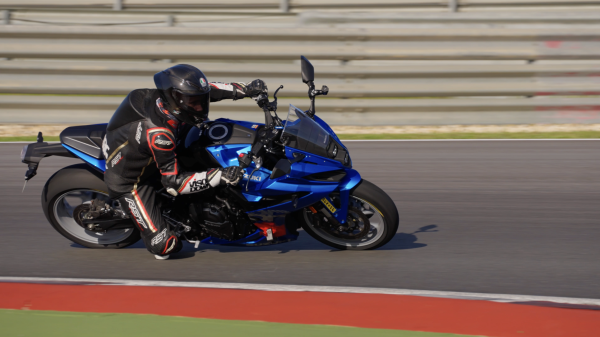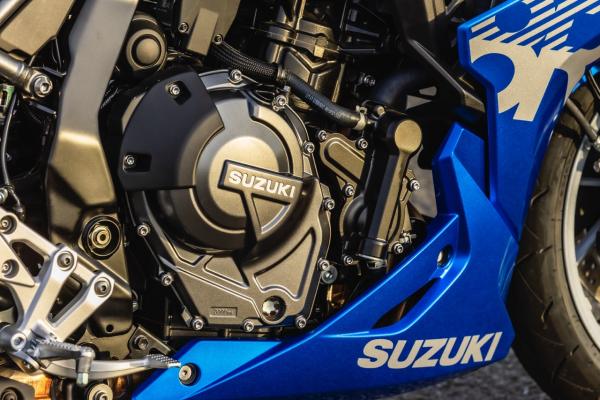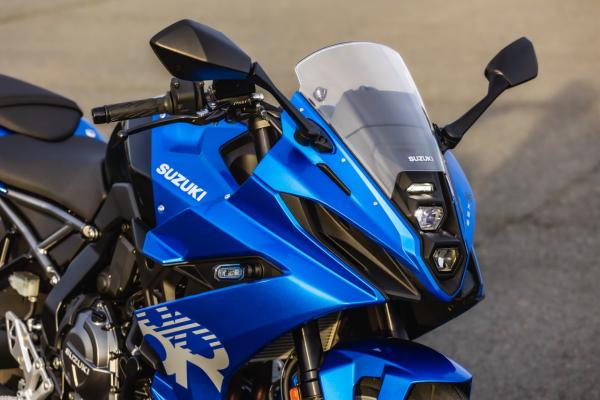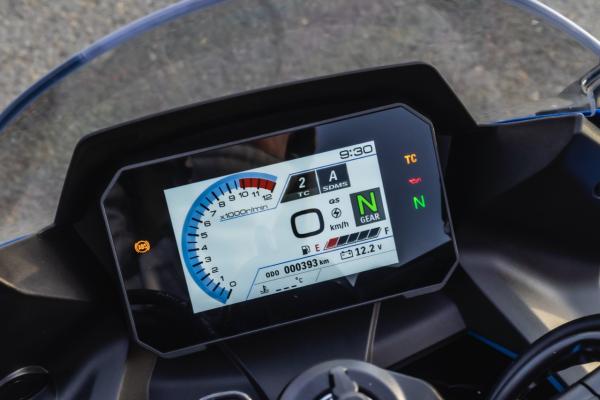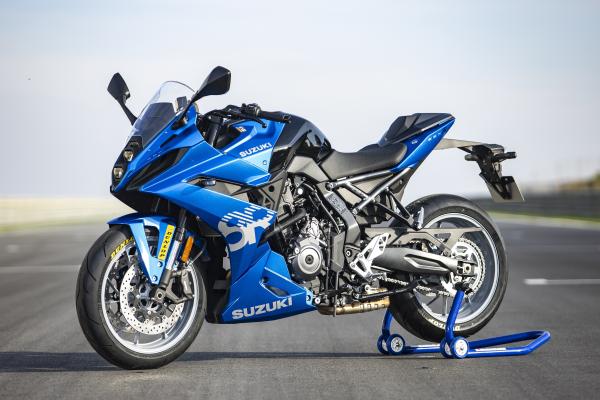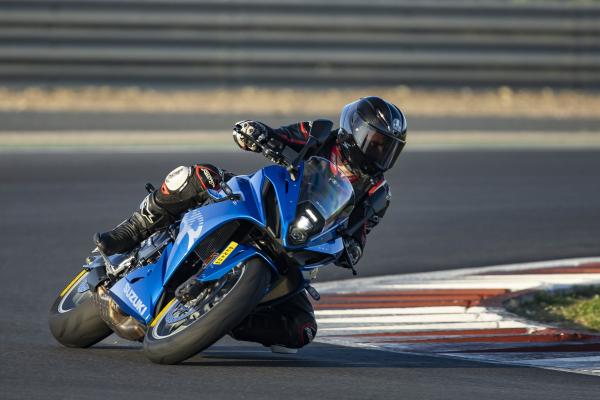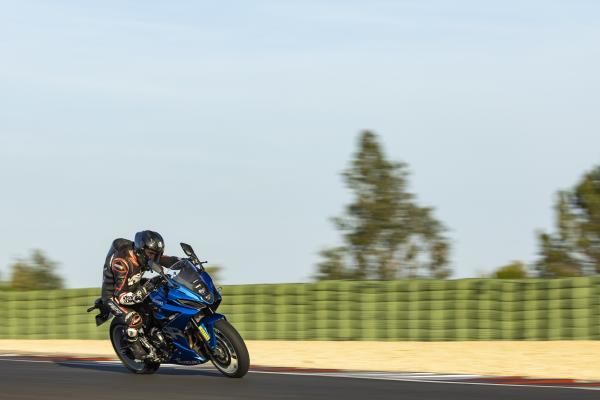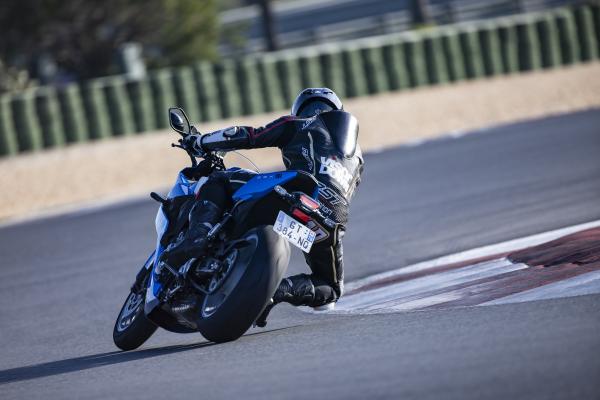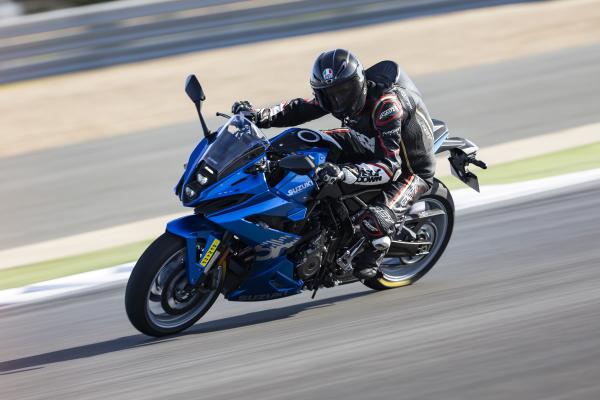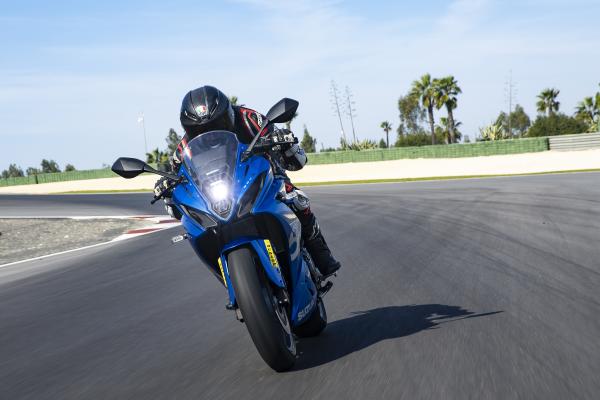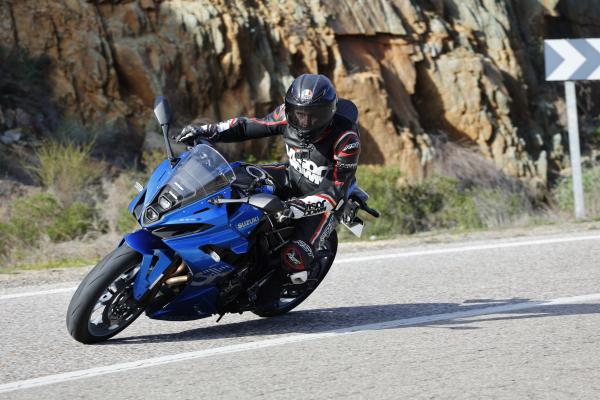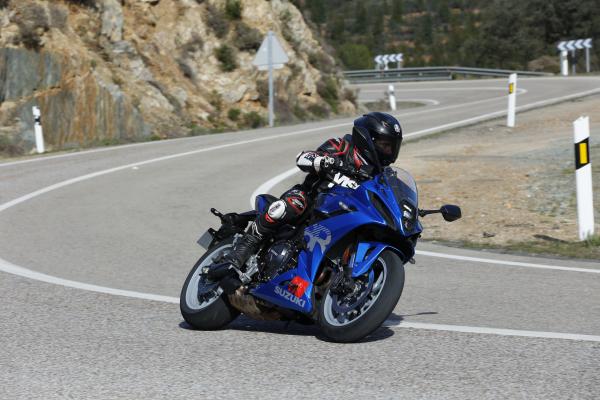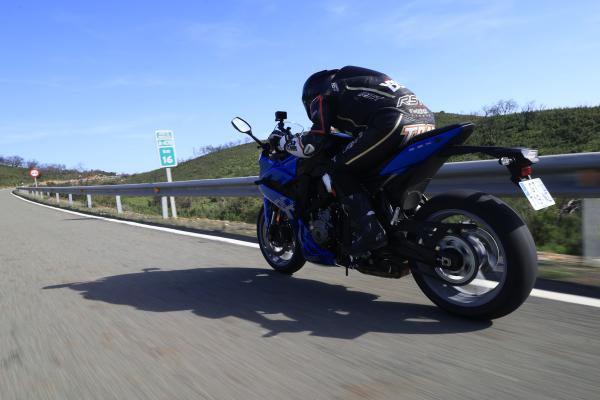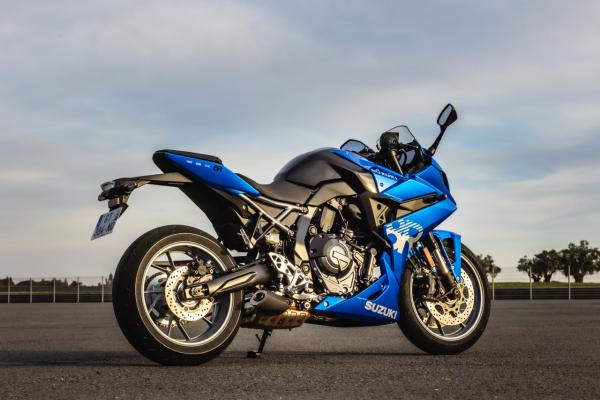Suzuki GSX-8R (2024) Review: Is The R7 In Trouble?
Suzuki’s first all-new sports bike in a decade lands in 2024, in the form of the GSX-8R, a parallel twin to take on the new breed of supersports bikes

Member for
54 years 8 monthsActual all-new motorbikes from Suzuki are a bit like buses - you wait 20-odd years for one, and then a few arrive all at once. The latest fruit to fall from Suzuki’s big blue tree is the new GSX-8R, and like a lot of modern sports bikes on the market, it has more in common with a naked sibling than a championship podium.
It is, of course, based on the Suzuki GSX-8S naked, a bike launched in 2021 at the EICMA show. The silk blanket had barely touched the floor and already people (myself included) were musing about how easy it would be to turn it into a sports bike, ready to take the fight to the already existing Aprilia RS660 , Yamaha R7 and more.
Suzuki listened to that noise, and to sample the new machine I’ve been flown out to sunny Seville for a one-day test, starting on the Monteblanco circuit in the morning and then threading up into the mountains in the afternoon.
How is the GSX-8R different to the GSX-8S?
As you can probably guess, the GSX-8R shares quite a bit with the GSX-8S and uses Suzuki’s first all-new frame and fresh engine in yonks. That involves a tubular steel frame with a separate aluminium subframe, which holds a 776cc parallel twin featuring the now customary 270-degree crankshaft. That gives the 8R a V-twin-like offset firing order, but it’s still a very different character, sound and delivery from the wheezy ol’ SV650.
From there, though, the 8R starts to deviate. Let’s start with the obvious - there’s now a full fairing with a windscreen, albeit integrating the double-stacked headlight arrangement of the 8S. There are now separate forged aluminium handlebars bolted to the triple clamp to give a sportier, forward riding position, but one that looks more akin to the Aprilia RS660 than the Yamaha R7 with its R6-like ergonomics.
Suzuki claims the riding position offers a “plugged-in riding experience, while also offering comfort”. Given the additional wind protection of the fairing and windscreen, you might well be able to tour on the GSX-8S without regretting your bike choice.
To go with the updated ergos and new bodywork is a more focused suspension setup tuned for the increased front weight bias, with the KYB arrangement of the 8S switched for one from Showa. At the front is the company’s catchily named Separate Function Fork - Big Piston (or SFF-BP), while at the rear there’s a preload-adjustable monoshock from the same firm.
Sticking with the chassis, the brakes are the same as those fitted to the 8S, comprising twin four-piston Nissin callipers at the front working on 310mm discs, with a single, 240mm disc and a single-piston calliper at the rear. The cast wheels are shod in Dunlop Sportmax Roadsport 2 tyres measuring 120/70ZR17 at the front and 180/55ZR17 out back.
Like the 8S (you’re sensing a theme here, aren’t you), there’s a Suzuki Drive Mode Selector (SDMS) with settings modes - A, B and C - for different throttle responses, three modes for the traction control including 'off' and basic 2-channel (not cornering) ABS. An up-and-down quickshifter is fitted as standard.
Price colours and availability
The GSX-8R lands in UK dealers in February 2024 and it is priced at £8,899 on the road and will come in Metallic Triton Blue, Metallic Matt Sword Silver and Metallic Matt Black colourways. The price makes it slightly more expensive than the slightly less powerful but more track-focused £8,700 Yamaha R7 and the inline four-cylinder Honda CBR650R. It does though come in cheaper than the much more electronically advanced £10,300 Aprilia RS660.
There is also a new contender in the mid-weight fight, in the form of the Triumph Daytona 660. It was only announced last month and while we haven’t ridden it yet (but we are very soon), the £8,595 Triumph triple cannot be counted out, bringing a low-price, road-focused dynamics and an in-line three-cylinder engine to the party.
What’s it like to ride on the track?
Our schedule for this launch was a morning on the track and an afternoon exploring the mountains and some roads that Suzuki GB promised us were ‘top-tier’. I’d normally jump at doing the track session before the road, but as the temperature hovers around eight degrees, the track conditions can only be described as sub-optimal.
Our bikes are equipped with Dunlop’s slightly sportier and stickier Sportsmart TT hoops, a 50/50 road/track day tyre that should give a little more grip on the recently resurfaced Monteblanco circuit than the OEM Dunlop Roadsport 2s.
The first session is an exercise in reminding myself which way the track goes, and there’s quite a bit to learn. The last time I was here was on the Ducati Streetfighter V2 launch, and since then the track has been 90 per cent resurfaced and is much smoother, with a less coarse layer of asphalt. Aside from a few rear-end slides out of slower corners early on, I like it.
The revised suspension of the 8R is a game-changer, and while a switch from KYB to Showa might seem like switching your running shoes from Puma to Nike, the revision makes a big difference to the way the bike rides. There’s less travel but a greater degree of plushness that you only get from more premium suspension, and that boosts the feel at both ends on the brakes and under acceleration. As with the GSX-8S, there is though still no adjustability at the front (and only a manual pre-load at the rear). Some of the rivals do boast this at a similar price point.
As session two kicks off, the track is now getting up to temperature, and right from the off the tyres are much happier. I’ve now got even more confidence on the brakes into the slower corners and that’s highlighting another feature of the bike which feels decidedly different from the naked sibling.
The braking hardware is the same as is found on the GSX-8S, although now mated to the slightly higher spec suspension they feel super powerful while not being over-aggressive or sharp. And there is no trick radially-mounted master cylinder doing the heavy lifting, just a simple span adjustable lever that gives a decent level of feel. I was also impressed that after a morning of track riding, there was no brake fade to be felt at all. The layout of Monteblanco we were riding has four heavy braking areas, and you’d normally forgive a bike in this segment for having a spongy brake, especially after three 20 to 25-minute sessions.
If there is one thing about the new GSX-8R that isn’t lending itself totally to track work it's the riding position. It’s very relaxed across the board, with wide clip-ons that are top-mounted and high-set, and low-set pegs that are taking chunks out of my Alpinestars boots. It’s not that I can grumble too much at this point in the day though, as with our road ride still to take place, I’m sure that relatively upright riding position will start to come into its own later on.
Another point of note, and not necessarily a gripe, is that the gearbox does require a positive prod down the gearbox, especially coming down from third to second. I couple of times in the first sessions I found the shift to be a bit belligerent, and I ended up helping it along with a blip of the throttle. A more forceful left foot for sessions two and three solved that issue though - some adjustment of the gear lever would probably help this further.
The ABS is worth mentioning too, and while it's not the most sophisticated system in the segment - the R7 and RS660 both gain IMU system - the 2-channel system works well on track and only more experienced track riders will feel the need to switch it off. They’ll need to do so via the old-school ABS fuse removal method, as sadly there is no option to do it via the settings.
Overall though, the GSX-8R performs well on track. It has a great chassis, with excellent suspension and brilliant brakes. The riding position is leaning to the more relaxed side of modern-day supersports - especially when compared to the RS660 and R7 - but given that the majority of these bikes will spend more of their time on the road than on the track, I’m not sure that's a bad thing.
The engine, as it is in the 8S, is the star of the show though, managing to be refined, grunty and easy-going, all from the same slimline package. Riding on a track with a torquey parallel twin makes so much sense, and should you fluff your lines (or gear changes) into one of the tighter turns you always seem to have enough shove to get back on track, something that would be much harder on a traditional inline-four 600cc screamer.
What’s it like to ride on the road?
With lunch now scoffed it’s time to sample the new 8R on what will be, for most of the time anyway, its natural habitat. Suzuki has promised us a belter of a road ride, and with our lead guide rider from Suzuki being well-known for stretching a bike's legs on a launch, it’s fair to say we are all itching to get going.
First, though, we have some town work to navigate, and while it's not what you’d call fun, it does at least give me a chance to get a feel for the bike's low-speed handling. There’s plenty of steering lock on offer on this thing, and while at a standstill the steering feels very heavy, as soon as you get rolling it lightens up. The clutch is nice and light too (it’s a slip/assist system) although at mid to low speed the quickshifter can feel a bit abrupt. Apart from that it’s great, the seat is low (810mm) and at 205kg ready-to-ride, it feels nicely manageable even for a shortarse like me.
As the roads improve the pace naturally rises, and we are being spoilt with some of the best fast sweepers I’ve ever ridden on. The wheelbase on the 8R is fairly long at 1,465mm, compared to the R7 at 1,395mm and the RS660 at 1,370mm. But what Suzuki has managed to do is not make a bike that feels cumbersome in tighter turns, while still having a high level of stability when you are going through a faster turn. Mid-corner bumps and lumps rarely stress the chassis, and the composure on the brakes when slowing into downhill hairpins is impressive.
I wasn’t keen on the relaxed riding position on the track, finding myself scraping boots and feeling like my upper body was awkwardly placed, but as expected, on the road it’s brilliant. The pegs still deck out fairly easily, but it’s so relaxed you can forgive the pain of replacing the hero blobs every once in a while. I also hopped on the pillion perch of another journos bike, and while there isn’t a grab rail to secure yourself on, the passenger gets a fairly spacious seat (for a sport bike anyway) with comfortable pegs and a seating position that doesn’t place them much higher than the rider of the bike.
Pulling in from the road ride there are a few points of note, with the comfort, stability, and the bike’s high-speed cornering performance being the main things. There’s one number though that doesn’t add up, and that’s the fuel economy. The quoted figure from Suzuki for the bike is 67.23 mpg based on the WMTC. At the end of our road ride, which was admittedly very brisk, I’d managed an impressive 34mpg. Taking that as given I’d have been getting a maximum range to empty of around 104 miles - not the 205 miles that Suzuki’s figures would lead you to believe.
In the bike's defence, they were all still fairly new, and despite being well passed the breaking-in phase, I’d still expect a little more economy to come from the engine. It also serves to highlight how floored the WMTC system is, which seems to be more of a finger-in-the-air assumption than a scientific calculation. It should be noted that we have managed better numbers from the GSX-8S in the UK.
Should you buy a Suzuki GSX-8R?
The new 8R is one of those bikes that you don’t think is going to be quite as good as it is. On the face of it, it’s a revamped version of a naked with some minor suspension tweaks and not much more going on. To ride though it's a very different machine. It’s light feeling and agile around town and loves being pointed along a fast-sweeping road. The engine is a characterful gem that’s hugely versatile - I’ve yet to encounter a bike that features Suzuki’s new parallel twin-cylinder that it hasn’t felt totally at home in.
Suzuki has pitched this bike into a funny space in the new supersports landscape. It has almost the same performance, ability, and handling dynamics as the bikes at the very top of the table, but with extremely easy-going ergonomics and a level of accessibility that makes it feel like anyone could hop on it for a ride.
The price point is vital in this segment though, and that might be a sticking point for some. Suzuki is famous for offering bikers cut-price options that still deliver when it comes to the overall riding experience. While it does deliver on the last point, the pricing is competitive, rather than bargain basement. With that in mind, a question mark does remain on whether the slightly sexier options in the form of the R7, RS660, and incoming Daytona 660 will win over the punters on the dealership floor.
